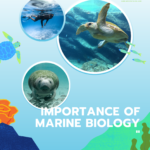
More than 70% of the surface of the Earth is covered by the ocean, which is also home to a wide variety of marine life, from tiny plankton to enormous whales. The marine biodiversity is essential to maintaining the planet’s health since it controls the climate, nutrient cycles, and overall health of the planet’s ecosystems. Because of this, the variety of marine life is extremely important, and there are numerous reasons why we should preserve and safeguard this biodiversity.
Importance of Marine Biodiversity
Ecological Importance of marine ecosystem: Many different species, each with a special function in the ecosystem, can be found in the ocean. Complex interactions between these species result in sophisticated food webs that sustain the entire marine ecosystem. The equilibrium of these food webs is maintained by biodiversity, preserving the ecosystem’s health and stability. Additionally, it contributes to the resilience of the ocean to environmental change because an ecosystem with variety is better able to adapt to shifting environmental factors.
Economic Importance of Marine life: Millions of people worldwide rely on the marine ecosystem as a major source of food and income. A major amount of the protein ingested by people comes from fish and other seafood, which is also a key source of revenue for many coastal towns. A variety of ecosystem services that the ocean offers, such as carbon sequestration, nitrogen cycling, and climate management, are also of substantial economic importance.
Scientific Importance of Marine Life: Many new species and ecosystems have yet to be discovered in the ocean, which is an enormous and largely unexplored frontier. Understanding the intricate relationships between species and ecosystems and the development of life on Earth can both be gained from research into marine biodiversity. Many marine species also possess special biochemical traits that could be applied to medicine as well as other fields.
Cultural Importance of Marine Life: For many communities all throughout the world, the ocean is a significant cultural and spiritual resource. It has contributed significantly to the advancement of human civilization and served as a source of inspiration for art, literature, and music. Therefore, protecting the ocean’s biodiversity is crucial for both environmentally friendly and economic reasons as well as for cultural and spiritual ones.
Ecological importance of Marine biodiversity
A vast network of interconnected organisms that depend on one another for survival can be found in the ocean. For instance, zooplankton makes up the base of the ocean’s food chain and feeds larger marine species like fish, whales, and dolphins, while phytoplankton is in charge of producing more than half of the oxygen in the atmosphere. A single species’ extinction can have a ripple impact on the ecosystem as a whole, altering the food web, nutrient cycling, and even temperature regulation.
According to a 2018 study that appeared in Nature, ocean biodiversity loss can reduce the amount of carbon that the ocean can absorb by 5–10%, which might have a big impact on how the world’s climate is regulated. Giakoumi, S.; Sala, E. (2018). Another study from 2016 indicated that the kelp forest ecosystem can undergo major changes as a result of the extinction of just one species of the sea otter, involving an increase in sea urchins and a decline in fish populations (Estes et al., 2016).
Economic importance of Marine biodiversity
A vital resource for human societies, the ocean offers a variety of products and services like food, energy, and medicines. Millions of people throughout the world rely solely on fishing for their livelihoods, and the global seafood business is worth more than $150 billion. M. J. Spalding (2016). With the ocean absorbing more than 90% of the excess heat produced by greenhouse gas emissions, marine ecosystems also play a crucial role in regulating the climate of the planet. Greene, C. H., Scott-Buechler, C. M. (2019). According to a 2012 study published in Nature, fisheries, tourism, and climate control make up the majority of marine biodiversity’s annual economic value, which is estimated to be $2 trillion (Costello et al., 2012).
Threats to Marine biodiversity:
Despite the vital importance of oceanic biodiversity, human activities like overfishing, pollution, climate change, and habitat destruction pose unprecedented threats to marine ecosystems. The world’s fish populations have been depleted only as a result of overfishing, and numerous species are now in danger of going extinct (Gebremedhin et al., 2021).
According to Worm et al. (2017), an estimated 8 million tonnes of plastic are anticipated to enter the ocean each year, endangering marine life and the health of entire ecosystems. Ocean acidification, sea-level rise, and rising sea temperatures are all having a substantial influence on marine ecosystems, making climate change one of the biggest threats to marine biodiversity.
Consequences of declining Marine biodiversity
Impacts on food webs: Food webs can be disturbed by declining biodiversity, which can have a ripple impact on the ecosystem as a whole. For instance, if a particular fish or plankton species goes extinct, it may have an impact on the entire food chain, including the creatures that consume it and those that are in turn consumed by it (Fung, et al., 2015).
Loss of genetic diversity: The genetic makeup of extinct species is irretrievably gone. Populations may see a decrease in genetic variety as a result, making them more susceptible to illnesses and environmental disturbances (Lourenço et al., 2016).
Loss of ecosystem services: The capacity of ocean ecosystems to offer human services like fisheries, tourism, and coastline protection can be impacted by biodiversity loss. Along with ecological effects, this may also have economic and social ones (Beaumont et al., 2019).
Increased vulnerability to climate change: Ocean ecosystems may be more susceptible to the effects of climate change, such as ocean acidification and rising sea temperatures if biodiversity is lost. This may result in further biodiversity losses, starting a feedback loop (Wabnitz et al., 2018).
Impacts on human health: Due to the fact that many marine organisms are used as food or in traditional medicine, biodiversity loss can also have an effect on human health. Loss of these species may be harmful to human health and well-being Worm, B., & Paine, R. T. (2016).
What we can do to protect ocean biodiversity:
Reduce plastic pollution: Oceanic plastic waste can destroy marine life and weak ecosystems. By using reusable bags, water bottles, and utensils, you may lessen the pollution caused by plastic. Be sure to recycle as much plastic as you can and dispose of it properly Stafford, R., & Jones, P. J. (2019).
Support sustainable fishing practices: Oceanic biodiversity is seriously threatened by overfishing. By purchasing seafood that has received certification from agencies like the Marine Stewardship Council, you can support environmentally friendly fishing methods Barnes, R. (2010).
Reduce carbon emissions: Oceanic biodiversity is negatively impacted by climate change. By avoiding driving whenever feasible and instead taking the bus, biking, or walking, you may lessen your carbon impact. Additionally, you can back businesses and politicians who make reducing carbon emissions a top priority (Hendriks et al., 2010).
Support marine conservation organizations: Oceana, The Ocean Foundation, and the World Wildlife Fund are just a few of the organizations that fight to preserve maritime biodiversity. To help them out, you may contribute money or provide your time (Zha et al., 2020).
Reduce fertilizer and pesticide use: Harmful algal blooms and other types of pollution that threaten marine life can be brought on by agricultural runoff. Utilizing organic fertilizers and pesticides, as well as correctly disposing of hazardous chemicals, will help you lessen your impact (Magris et al., 2021).
Reduce energy consumption: Petroleum and coal, both of which are causing climate change and ocean acidification, are just one of the numerous kinds of energy we consume. Turning off lights and devices when not in use, adopting energy-efficient appliances and light bulbs, and utilizing renewable energy sources like solar and wind power can all help you minimize your energy consumption Hilborn, R. (2014).
Reduce water usage: Due to its scarcity, freshwater can harm marine habitats when used excessively. By taking shorter showers, repairing faulty faucets, and utilizing drought-resistant landscaping, you may reduce your water usage (Molnar et al., 2008).
Educate others: Inform your loved ones, friends, and neighbors about the necessity of preserving ocean biodiversity. Motivate them to take the initiative and alter their lifestyles to safeguard the oceans
Conservation Efforts
Around the world, efforts are being made to protect and conserve oceanic biodiversity through a number of programs designed to lessen the negative effects of human activity on the marine ecosystem. The creation of marine protected areas, the adoption of sustainable fishing methods, and the decrease in marine pollution are some of these projects. The general public is also becoming more aware of the significance of oceanic biodiversity, which is resulting in a rise in support for conservation initiatives.
Conclusion
The ocean’s biodiversity is vital to the planet’s health because it offers crucial ecological and commercial functions. To safeguard and conserve oceanic biodiversity, urgent action is required as marine ecosystems face unprecedented pressures from human activity. Ocean biodiversity is extremely significant since it offers a variety of ecological, economic, scientific, and cultural advantages. However, a number of human activities are endangering this biodiversity, so immediate action is required to protect and preserve the ocean ecosystem. We can guarantee that the ocean ecosystem is healthy and thriving for future generations by cooperating to lessen our impact on it.
References:
Barnes, R. (2010). Fisheries and marine biodiversity. In Research Handbook on International Environmental Law. Edward Elgar Publishing.
Beaumont, N. J., Aanesen, M., Austen, M. C., Börger, T., Clark, J. R., Cole, M., … & Wyles, K. J. (2019). Global ecological, social and economic impacts of marine plastic. Marine pollution bulletin, 142, 189-195.
Costello, C., Kinlan, B. P., Lester, S. E., & Gaines, S. D. (2012). The economic value of rebuilding fisheries.
Estes, J. A., Heithaus, M., McCauley, D. J., Rasher, D. B., & Worm, B. (2016). Megafaunal impacts on structure and function of ocean ecosystems. Annual Review of Environment and Resources, 41, 83-116.
Estes, J. A., Heithaus, M., McCauley, D. J., Rasher, D. B., & Worm, B. (2016). Megafaunal impacts on structure and function of ocean ecosystems. Annual Review of Environment and Resources, 41, 83-116.
Gebremedhin, S., Bruneel, S., Getahun, A., Anteneh, W., & Goethals, P. (2021). Scientific methods to understand fish population dynamics and support sustainable fisheries management. Water, 13(4), 574.
Hilborn, R. (2014). Protecting marine biodiversity with “new” conservation. Cool Green Science.
Magris, R. A., Costa, M. D., Ferreira, C. E., Vilar, C. C., Joyeux, J. C., Creed, J. C., … & Floeter, S. R. (2021). A blueprint for securing Brazil’s marine biodiversity and supporting the achievement of global conservation goals. Diversity and Distributions, 27(2), 198-215.
Molnar, J. L., Gamboa, R. L., Revenga, C., & Spalding, M. D. (2008). Assessing the global threat of invasive species to marine biodiversity. Frontiers in Ecology and the Environment, 6(9), 485-492.
Sala, E., & Giakoumi, S. (2018). No-take marine reserves are the most effective protected areas in the ocean. ICES Journal of Marine Science, 75(3), 1166-1168.
Spalding, M. J. (2016). The new blue economy: the future of sustainability. Journal of Ocean and Coastal Economics, 2(2), 8.
Stafford, R., & Jones, P. J. (2019). Viewpoint–Ocean plastic pollution: A convenient but distracting truth?. Marine policy, 103, 187-191.
Ten Brink, P. (Ed.). (2011). The economics of ecosystems and biodiversity in national and international policy making. Routledge.
Wabnitz, C. C., Lam, V. W., Reygondeau, G., Teh, L. C., Al-Abdulrazzak, D., Khalfallah, M., … & Cheung, W. W. (2018). Climate change impacts on marine biodiversity, fisheries and society in the Arabian Gulf. PloS one, 13(5), e0194537.
Worm, B., & Paine, R. T. (2016). Humans as a hyperkeystone species. Trends in ecology & evolution, 31(8), 600-607.
Zhao, Q., Stephenson, F., Lundquist, C., Kaschner, K., Jayathilake, D., & Costello, M. J. (2020). Where marine protected areas would best represent 30% of ocean biodiversity. Biological Conservation, 244, 108536.
Check Other Schlorships:
- FREE Earth-inspired courses
- The Graduate Application Portal for King Fahd University, Saudi Arabia is open.
- International Excellence Scholarship 2023-24
- Scholarship in USA
About the authors:
Muhammad Qasim1, Nimra Ather2
1Department of Environmental Sciences, Government College University Faisalabad
2Department of Zoology, University of Agriculture Faisalabad

